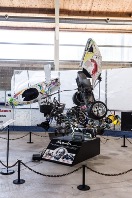SHUTTLECOCK
Between Race and Tinguely Machine
☑️ ERRATA ⬅️
Tutorial:
How to make a cymbal « scream »?
Comment faire « crier » une cymbale?
Wie man ein Becken zum „Schreien“ bringt?

Mechanical sports were a great passion of the Fribourg artist Jean Tinguely. Throughout his life, he drew inspiration from and immersed himself in this world to create some of his “machines.” Among his works is René Progin’s sidecar, which Jean Tinguely painted in 1988 for participation in the world championship. The following winter, this sidecar was transformed by the artist into a large sculpture (approximately 10m² and 3.5m high), which he named Shuttlecock, in reference to a turn of the same name on the St. Moritz bobsleigh track.
For his composition, Marc Jeanbourquin drew melodic, thematic, and rhythmic elements from various sources, using and developing them in a manner similar to the artist’s approach to creating his sculptures. At times, an ostinato evokes the movement of Tinguely’s machines, which lead nowhere. Meanwhile, the more virtuosic and rapid passages can easily be associated with motor racing circuits, where the famous sidecar would have had to navigate dangerous turns. In this regard, it is worth noting that all tempo transitions are mathematically structured.
In his composition, Marc Jeanbourquin incorporated some unusual percussion elements, such as the Suspended Cymbal Scream! effect—literally making the cymbal “scream.” This is achieved by gently “scratching” the top of the cymbal with a drumstick (held perpendicular to the surface). Striking a metal bar with metal drumsticks, for instance, produces the desired effect for the beginning. The conductor and percussionists will surely find the right metallic material to achieve the best effect.
Der Motorsport war eine große Leidenschaft des Freiburger Künstlers Jean Tinguely. Daher ließ er sich sein ganzes Leben lang von diesem Milieu inspirieren und involvierte es, um einige seiner « Maschinen » zu erschaffen. Zu seinen Werken gehört auch der Seitenwagen von René Progin, den Jean Tinguely 1988 für die Teilnahme an der Weltmeisterschaft bemalt hatte. Im darauffolgenden Winter wurde dieser Seitenwagen vom Künstler in eine große Skulptur (ca. 10m² und 3,5m hoch) verwandelt, die er Shuttlecock nannte, in Analogie zu einer gleichnamigen Kurve auf der Bobbahn von St. Moritz.
Für seine Komposition entnahm Marc Jeanbourquin hie und da melodische, thematische und rhythmische Elemente, die er, ähnlich wie ein Künstler, für die Schaffung seiner Skulpturen verwendet und weiterentwickelt. Manchmal erinnert ein Ostinato an die Bewegungen von Tinguelys Maschinen, die nirgendwohin führen. Die virtuoseren und schnelleren Passagen kann man leicht mit Autorennstrecken in Verbindung bringen, wo der berühmte Seitenwagen einige gefährliche Kurven zu bewältigen hat. In diesem Zusammenhang ist zu beachten, dass alle Tempoübergänge mathematisch sind.
In seiner Komposition hat Marc Jeanbourquin einige besondere Percussion-Elemente verwendet, wie z. B. den Effekt « Suspended Cymbal Scream! », bei dem das Becken wortwörtlich zum Schreien gebracht wird. Dabei muss die Oberseite des Beckens mit einem Stock (senkrecht zur Oberfläche) sanft « zerkratzt » werden. Wenn Sie mit Metallstäben auf eine Metallstange schlagen, erzielen Sie den gewünschten Effekt « Metal Bar », z. B. für den Anfang. Der/die Dirigent/in und seine/ihre Perkussionisten finden bestimmt das Metallmaterial für den besten Effekt.
Le sport mécanique était une grande passion de l’artiste fribourgeois Jean Tinguely. Il s’est donc inspiré et impliqué de ce milieu, tout au long de sa vie, pour créer certaines de ses « machines ». Parmi ses œuvres, on trouve le side-car de René Progin, que Jean Tinguely a peint en 1988 pour la participation au championnat du monde. L’hiver suivant ce side-car est transformé par l’artiste en une grande sculpture (environ 10m² et 3,5m de haut) qu’il a nommée Shuttlecock, par analogie avec un virage du même nom sur la piste de bob de St-Moritz.
Pour sa composition, Marc Jeanbourquin a puisé ça-et-là des éléments mélodiques, thématiques et rythmiques, qu’il utilise et développe, un peu à la manière de l’artiste, pour créer ses sculptures. Par moment un ostinato n’est pas sans rappeler les mouvements des machines de Tinguely, qui ne mènent nulle part. Quant aux passages plus virtuoses et rapides, on pourra aisément les associer aux circuits de course automobile, où le fameux side-car sera amené à négocier certains virages dangereux. À ce sujet, il est à noter que toutes les transitions de tempo sont mathématiques.
Dans sa composition, Marc Jeanbourquin a utilisé quelques éléments de percussion particuliers comme les effet « Suspended Cymbal Scream ! », littéralement en faisant crier la cymbale. Il faudra «rayer» gentiment le dessus de la cymbale avec une baguette (perpendiculaire à la surface). En frappant avec des baguettes métalliques sur une barre de métal «Metal bar», on obtiendra l’effet voulu pour le début par exemple. Le/la chef/fe et ses percussionnistes trouveront certainement le matériau métallique pour obtenir le meilleur effet.

